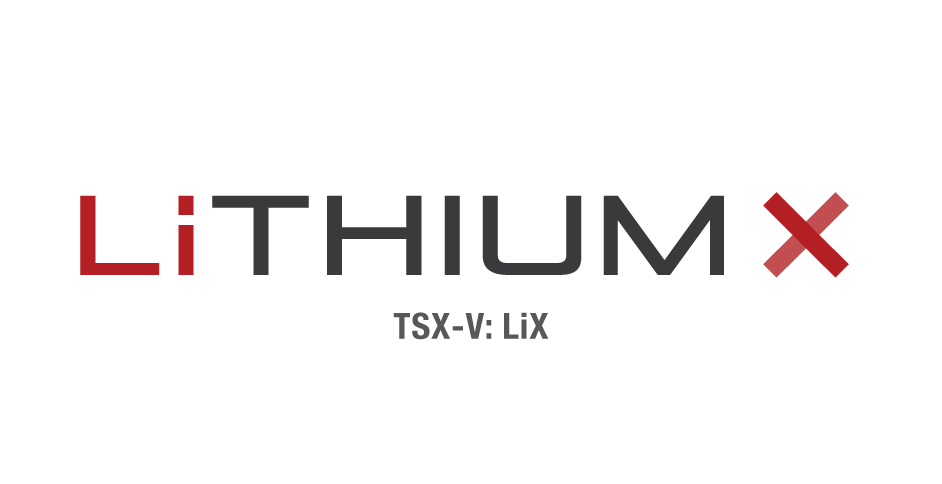Highlights:
- NI 43-101 Mineral Resource Estimate of 194,860 tonnes of lithium (1,037,000 tonnes of lithium carbonate equivalent) of Indicated, and 189,130 tonnes of lithium (1,007,000 tonnes of lithium carbonate equivalent) in Inferred category.
- Significant potash by-product resource of 2,143,491 tonnes of potassium (4,088,000 tonnes of potassium chloride) Indicated, and 2,068,161 tonnes of potassium (3,948,000 tonnes potassium chloride) Inferred.
- High average grade of Indicated resource of 501 milligrams per litre (mg/L) lithium and 5,512 mg/L potassium
- Low average magnesium to lithium ratio of 3.8
- Feasibility Study underway
VANCOUVER, Aug. 30, 2016 /CNW/ – Lithium X Energy Corp. (“Lithium X” or the “Company“) (TSX-V: LIX) (OTCQB: LIXXF), is pleased to report the filing of a National Instrument 43-101 technical report prepared by FloSolutions (Chile), dated August 30, 2016 and entitled Resource Estimate for Lithium & Potassium, Sal de los Angeles Project, Salta (Argentina) containing its first independent lithium (“Li”), potassium (“K”) and boron (“B”) resource estimate for the Sal de los Angeles brine project at Salar de Diablillos (the “Project”). Lithium X holds a 50% interest in the Project and can acquire an additional 30% interest (see March 3, 2016 news release).
The NI 43-101 resource estimate, prepared by FloSolutions and summarized in Table 1 below, includes an Indicated component of 194,860 tonnes of lithium at an average grade of 501 milligrams per litre (“mg/l”) (1,037,000 tonnes of lithium carbonate equivalent) (“LCE”) and 2,143,491 tonnes of potassium at an average grade of 5,512 mg/l (4,088,000 tonnes of potash (“KCl”) equivalent). The resource estimate also established an inferred resource of 189,130 tonnes of lithium at 410 mg/l (1,007,000 tonnes of LCE) and 2,068,161 tonnes of potassium at 4,489 mg/l (3,948,000 tonnes KCl equivalent).
The resource estimate establishes Sal de los Angeles as a large and high grade undeveloped lithium brine project, with a Feasibility Study underway.
Brian Paes-Braga, Founder and CEO of Lithium X, commented, “This resource estimate confirms the significance of the Sal de los Angeles deposit and will form the basis of a Feasibility Study. Our experienced operating team, led by Eduardo Morales, continues with ongoing processing and engineering work. These are major steps towards bringing Sal de los Angeles into commercial production.”
Table 1. Sal de los Angeles Brine Resource Statement
 |
Notes to this resource statement:
- CIM definitions were followed for Mineral Resources.
- The Qualified Person for this Mineral Resource estimate is Frits Reidel, CPG.
- The Qualified Person relied entirely on data provided by Lithium X Energy for the preparation of the resource estimate and no independent data collection was carried out to verify the accuracy of the data provided by LiX.
- A lithium cut-off concentration of 100 mg/L has been applied to the resource estimate.
- Numbers may not add due to rounding.
The effective date is August 29, 2016.
The reader is cautioned that mineral resources are not mineral reserves and do not have demonstrated economic viability.
“The deposit is open to the north, where Lithium X has the opportunity to grow the resource through further drilling,” commented Paul Matysek, Executive Chairman of Lithium X.
“The indicated resource defines a high-grade core in the northern portion of the basin that will be the focus of further work leading to the design of a production well field in this area,” Matysek said. “We expect to continue advancing the project at a fast pace and converting the indicated resource into reserves.”
“The overall quality of the brine continues to impress with its low level of impurities,” commented Eduardo Morales, Chief Operating Officer of Lithium X. “We now have an indicated resource allowing us to develop a Feasibility level study. Lithium X is assembling a team of in-house and external consultants, led by Andres Barrientos and myself, to advance Sal de los Angeles through feasibility and on to construction as efficiently as possible.”
“The quality and quantity of the Sal de los Angeles brine should allow for a world-class operation. We intend to demonstrate the viability of such an operation in the coming months,” Morales said.
The resource estimate was prepared in accordance with the guidelines of National Instrument 43-101 and uses best practice methods specific to brine resources, including a reliance on core drilling and sampling methods that yield depth-specific chemistry and drainable porosity measurements. The resource calculations were also confirmed using two different resource models. The work was completed by independent qualified person Mr. Frits Reidel of international hydrogeology firm FloSolutions.
The resource is defined by reverse circulation and core drilling, but it has also been sampled by low-flow pumping and pumping tests in numerous locations. The footprint of the resource is 55 square kilometres. The new Indicated, and Inferred resource incorporates 21 reverse circulation holes and 7 diamond drill core holes, for a total of 6,270 metres of drilling in 28 holes. This equates to nominal drill spacing of 2 boreholes per square kilometre. Over most of the basin, the brine resource comes to within a few metres of the surface and its thickness is defined by the basement contact, which itself was defined by drilling and seismic tomography surveys. The brine resource was defined from 5 metres to more than 185 metres depth in one area.
The resource estimate confirms the favourable chemistry of the Sal de los Angeles brine. The low magnesium to lithium ratio has been shown to be a significant factor in reducing the use of common reagents employed during lithium concentrate production using conventional solar ponds. Some important parameters of the brine composition are:
- Average density of the brine: 1.10 g/cm3
- Average Magnesium/Lithium ratio: 3.8
- Average Sulphate/Lithium ratio: 14.6
Based on the geological model, approximately 95% of the brine volume in this resource is hosted by predominantly sand and gravel aquifers; the balance is hosted in silt or clay dominated units.
The total contained lithium and potassium values are based on measurements of drainable porosity distributed throughout the aquifer volume that defines this resource and by pump tests performed within the indicated portion of the resource estimate. These methods of porosity determination, or specific yield, are designed to estimate the portion of the total porosity that can reasonably be expected to be drained by pumping; however, these in situ estimates may differ from total extractable quantities. The porosity of the resource volume varies with geology and the average for the entire database is approximately 12%. These porosity values compare favourably to other unconsolidated, clastic basins similar to Diablillos.
Resource Estimation Methodology
The resource estimate was developed for the Lithium X Sal de los Angeles Project using SgeMS software. Dr. Gregoire Mariethoz, Professor at the University of Lausanne, Switzerland led the numerical model effort to develop the resource estimate. The author was in close communication with Dr. Mariethoz throughout the model development process; all results have been reviewed and checked at various stages and are believed to be valid and appropriate for these resource estimates.
The total resource is calculated by multiplying, on the entire grid, the lithium concentration by the porosity. The overall resource is then estimated by taking the average of this weighted concentration on the entire grid.
The following steps were carried out to calculate the lithium, potassium and boron resources.
1) Adjust a variogram on the data in x, y and z directions.
2) Definition of model grid (52,154 nodes) and node size (x =150 m, y=150, z=6m).
3) Interpolation of Li, K B and Specific Yield in each node in g/m3 using kriging with the variogram models of step 1.
4) Calculation of total resource.
5) Preparation of grade-tonnage curve for Li.
The primary analytical laboratory for the data used in this resource is ALS Environmental laboratory of Fort Collins, Colorado. ALS labs are accredited to ISO 9001:2008 and ISO14001:2004 for its geochemical and environmental labs for the preparation and analysis of numerous sample types, including waters. The details of analytical methodologies and quality assurance protocols are reported in the NI 43-101 technical report for the project, which is filed on SEDAR.
The porosity determinations were made by Daniel B. Stephens & Associates, Inc. Soil Testing and Research laboratory of Albuquerque, New Mexico. For 30 years, the DBS&A Soil Testing & Research Laboratory has been the premier provider of consistent and reliable soil properties testing. It is also the go-to facility for research, development, and implementation of novel technologies and instruments to aid in successful project outcomes and project cost reductions. The laboratory adheres to standardized testing methods and industry accepted procedures established by the American Society of Testing and Materials (ASTM), American Association of State Highway and Transportation Officials (AASHTO), Methods of Soil Analysis (MOSA), American Petroleum Institute (API), American Society of Agronomy (ASA), and procedures developed and patented by DBS&A personnel.
The resource estimate and the information in this news release have been prepared and reviewed by Mr. Frits Reidel. Frits Reidel is a consulting hydrogeologist and is a Member of the American Institute of Professional Geologists. Mr. Reidel has sufficient relevant experience to qualify as a “Qualified Person” as defined in NI 43-101. Mr. Reidel has worked on lithium resource estimates for numerous brine projects including Salar de Hombre Muerto, Salar de Olaroz, Salar de Cauchari and Salar de Maricunga. Frits Reidel consents to the inclusion in this announcement of this information in the form and context in which it appears.
About Lithium X Energy Corp
Lithium X Energy Corp. is a lithium exploration and development company with a goal of becoming a low-cost supplier for the burgeoning lithium battery industry. Lithium X owns 50%, and has the option to acquire up to 80%, of the Sal de los Angeles lithium brine project in the prolific “Lithium Triangle” in mining friendly Salta province, Argentina, a well-known salar with positive historical economics, grade and size. Lithium X is also exploring a large land package in Nevada’s Clayton Valley, contiguous to the only producing lithium operation in North America – Silver Peak, owned and operated by Albemarle, the world’s largest lithium producer. Lithium X is listed on the TSXV under the trading symbol LIX.
For additional information about Lithium X Energy Corp., please visit the Company’s website at www.lithium-x.com or review the Company’s documents filed on www.sedar.com. Join the Company’s email list at https://lithium-x.com/subscribe.
ON BEHALF OF THE BOARD OF DIRECTORS
“Paul Matysek”
Paul Matysek
Executive Chairman
FOR FURTHER INFORMATION PLEASE CONTACT:
Brian Paes-Braga Investor Relations
President and CEO, Director Mario Vetro
Tel: 604-609-5137 Tel: 604-687-7130 ext. 200
Email: [email protected] [email protected]
Neither the TSX Venture Exchange nor its Regulation Services Provider (as that term is defined in the policies of the TSX Venture Exchange) accepts responsibility for the adequacy or accuracy of this news release.
This news release contains certain forward-looking information and forward-looking statements within the meaning of applicable securities legislation (collectively “forward-looking statements”). Certain information contained herein constitutes “forward-looking information” under Canadian securities legislation. Generally, forward-looking information can be identified by the use of forward-looking terminology such as “expects”, “believes”, “aims to”, “plans to” or “intends to” or variations of such words and phrases or statements that certain actions, events or results “will” occur. Forward-looking statements are based on the opinions and estimates of management as of the date such statements are made and they are subject to known and unknown risks, uncertainties and other factors that may cause the actual results, level of activity, performance or achievements of the Company to be materially different from those expressed by such forward-looking statements or forward-looking information, including the business of the Company and the commencement of trading in the Company’s shares. Although management of the Company has attempted to identify important factors that could cause actual results to differ materially from those contained in forward-looking statements or forward-looking information, there may be other factors that cause results not to be as anticipated, estimated or intended. There can be no assurance that such statements will prove to be accurate, as actual results and future events could differ materially from those anticipated in such statements. Accordingly, readers should not place undue reliance on forward-looking statements and forward looking information. The Company does not undertake to update any forward-looking statements or forward-looking information that are incorporated by reference herein, except as required by applicable securities laws.



